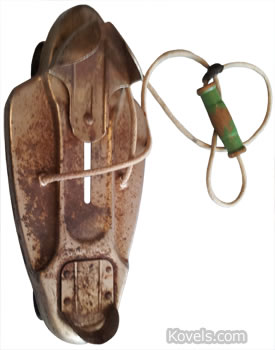Q: I would like to know what this is, who made it, and when it was made.
A: You have an old roller skate that could fit onto the bottom of a shoe. It looks as though someone pulled a cord through it to hang it for display. The bottom of the skate is adjustable so it can fit on various sizes of shoes. It probably had leather straps or some kind of tie that went through the two holes on the bottom and fastened the skate securely on the skater’s foot. Roller skates were first made in the 1700s in the Netherlands. Those skates, called “skeelers,” were made of wooden blocks with big wooden spool “wheels” on the bottom. The first patent for a roller skate was issued in 1760 to a Belgian inventor and musician, John Joseph Merlin. The story is that he wanted to make a grand entrance at a costume party and skated in while playing his violin. Unfortunately, he hadn’t figured out a way to stop and he crashed into a big mirror at the end of the room, smashing his violin. The first toe-stop was not invented until 1876, too late for Mr. Merlin. Many early skates had three “inline” wheels of various materials. In 1863 James Leonard Plimpton of New York invented the first “quad” roller skates, with four wheels in the configuration used on your skate. His patented design made it possible to turn easily and also to skate backwards. These were known as “rocking skates” because the front wheels turned by rocking on the foot plate. Your skate probably dates from the early decades of the 20th century. If you can find a manufacturer’s mark on your skate, you might be able to date it more precisely.




This skate was used like a scooter. You held on to the rope as you went along. I had one as a kid. I am now 77 years.